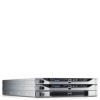Dell EqualLogic FS7500 Dell EqualLogic FS7500 - Unified block and file storage - Page 7
WMware I/O stacks,
 |
View all Dell EqualLogic FS7500 manuals
Add to My Manuals
Save this manual to your list of manuals |
Page 7 highlights
Dell EqualLogic FS7500 - Unified block and file storage for virtual workloads Figure 1. WMware I/O stacks In a SAN, when the VMware hypervisor is using the block-based FC, FCoE, or iSCSI protocol, it creates a VMFS file system on a storage volume (shown as VMFS Volume in Figure 1) to organize and store VMware files. The VMFS file system logic runs on the VMware server. Unlike SAN, in a FS7500 NAS, when the VMware hypervisor is using the NFS protocol, the NFS services running on the FS7500 controllers are responsible for running the file system logic. NFS is a file-based protocol that can be used to establish a client-server relationship between VMware vSphere hosts and a NAS storage system. NFS services running on the NAS device are responsible for managing the layout and structure of the files and directories on physical storage (shown as NFS Export in Figure 1). NFS services are also used for coordinating simultaneous storage access from multiple servers. vSphere hosts use these services to provide shared access for VMware VMs similar to that provided by VMFS when used with block storage. VMware has built full NFS support into the vSphere disk virtualization layer. VMware supports all major features such as VMotion™, VMware snapshot, VMware HA, and VMware DRS using NFS exports, at parity with VMFS volumes. This white paper is primarily concerned with NFS. From a technical perspective, the VMware hypervisor typically abstracts the I/O operations generated by the VM and processes them in a virtual disk file known as a VMDK file. This VMDK file is stored in a datastore presented to the ESXi host server. A datastore is a storage volume or file system repository that may contain the configuration and data files of one or more VMs. These datastores may either be block-based VMFS volumes (using iSCSI/FC/FCoE protocol) or file-based NFS exports (using the NFS protocol). In either case, from a functional point of view the VM is unaware of the underlying storage mechanism because the hypervisor handles all the I/O processing on the virtual machine's behalf. Page 5















